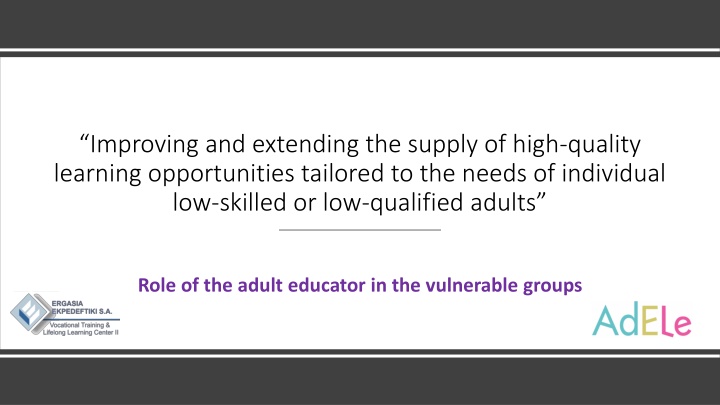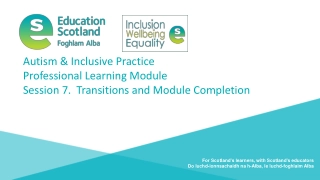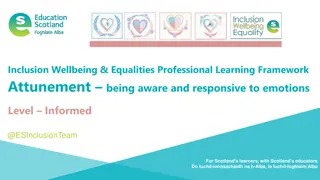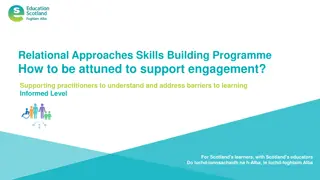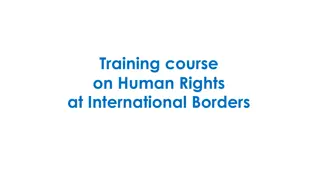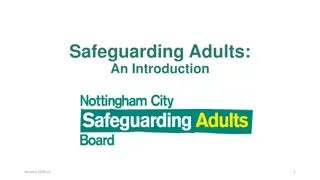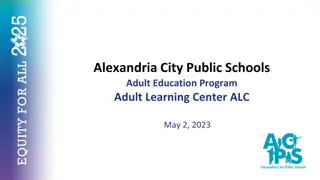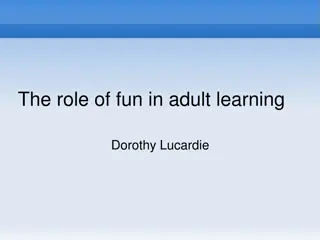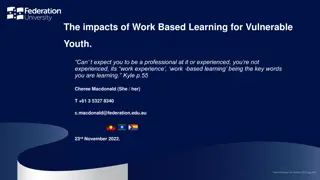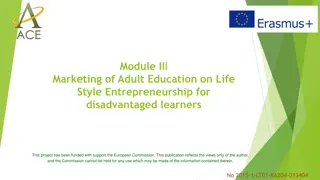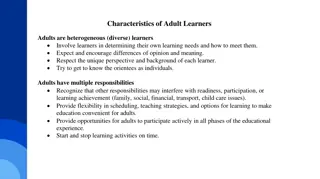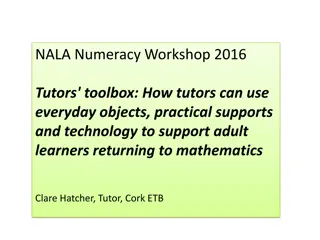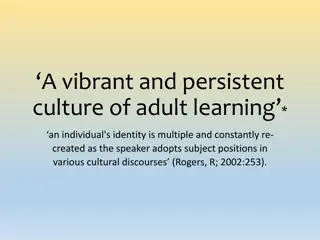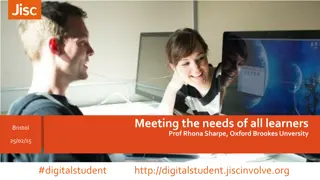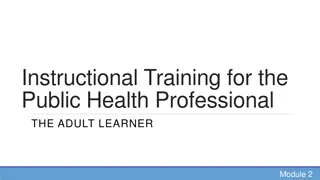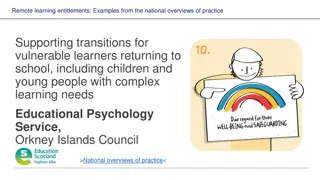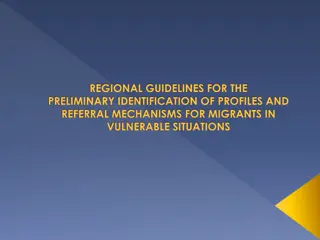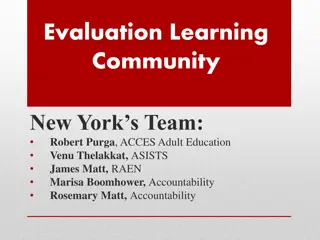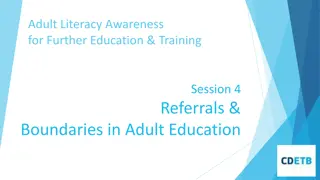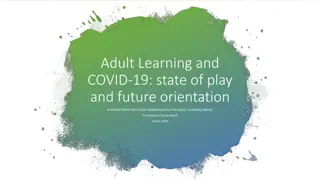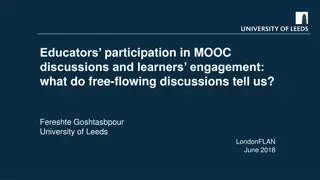Role of Adult Educators in Empowering Vulnerable Learners
Adult educators play a crucial role in providing tailored learning opportunities for low-skilled adults, fostering skill development, active citizenship, and social integration. By addressing the diverse needs of adult learners and offering training opportunities, educators help reduce social inequalities and enable individuals to thrive in the labor market. Understanding the characteristics of adult learners, such as their multiple roles and life experiences, is key to effectively supporting their educational journeys.
Uploaded on Mar 07, 2025 | 4 Views
Download Presentation

Please find below an Image/Link to download the presentation.
The content on the website is provided AS IS for your information and personal use only. It may not be sold, licensed, or shared on other websites without obtaining consent from the author.If you encounter any issues during the download, it is possible that the publisher has removed the file from their server.
You are allowed to download the files provided on this website for personal or commercial use, subject to the condition that they are used lawfully. All files are the property of their respective owners.
The content on the website is provided AS IS for your information and personal use only. It may not be sold, licensed, or shared on other websites without obtaining consent from the author.
E N D
Presentation Transcript
Improving and extending the supply of high-quality learning opportunities tailored to the needs of individual low-skilled or low-qualified adults Role of the adult educator in the vulnerable groups
Adult education contributes positively to the development of skills and competences which adults need throughout theirlives. Adult education contributes to the development of active citizenship. Adult educators play a significant role in creating the appropriate conditions in order to enforce adults attempts to re-join the educational system and to enter fields that require the acquisition of new knowledge and skills. By enabling adults to enter or re-enter the education system, their personal development and social integration arealso attained. Simultaneously, social inequalities are reduced, and marginalization and social exclusion are prevented. Adult educators can help low-skilled adults to improve their skills and competences and acquire further qualifications that will enable them to respond effectively tothe current demands of the labormarket. Thesystematic training ofadulteducatorsisa keyforsuccess. Adult educators need a wide range of training opportunities, which can help them upgrade their skills and competences and thus respond to the demands of their profession.
Characteristics of Adult Learners (1/6) Generally, we can assume that adult learners are engaged, at a given time, in multiple roles, which impact the time andenergytheycan devote totheirroleas a learner(Polson,1993,1). A challenge that the adult educator is presented with, is the fact that in the adult classroom there is much less homogeneity than in a traditional classroom, in terms of the learners developmental stage, age group and life transitions (Polson, 1993).
Characteristics of Adult Learners (2/6) According to Kokkos (2005, 86-93) adult learners Have established clear goals prior to their entry in the educational process. Most adults, in comparison to younger learners for which education is a given based on their age and developmental stage in which they are in, decide to enter in an educational programme for specific reasons and because a specific need include the following: Professional Fulfilment of social roles (e.g. parenting classes) Personal development For status Social Financial has been identified. Possible educational goals
Characteristics of Adult Learners (3/6) Have more life experiences. As adults, it is expected that adult learners bring to the educational programme more life experiences than the average typical learner. According to Polson simultaneously a strength and a barrier. It is a strength since these life experiences can be a foundation upon which to build new knowledge (Kokkos, 2005, 88). It can become a barrier though, because the adult learner has used these life experiences to form their set of values and beliefs, which if they are rigid may not be willing to accept the new knowledge and experiences learning has to offerto them (Polson, 1993). (1993), this can be
Characteristics of Adult Learners (4/6) Have developed theirown preferred learning style. Adults are in a continual process of learning (formal, non-formal, and informal) and they have settled on the learning styles that suit them the most. Rogers & Horrocks (2010, 91) state that as adult educators we must remember that our learner participants all have their own ways of learning which may differ from our ways of learning, and opportunities to exercise these have to be created if newlearning is to take place . Have a tendency for active participation and expect to be actively involved in the learning process. They need active rather than passive learning experiences and demand to be treated as mature and responsible individuals. Since adult learners enter education with specific goals, they are more likelytochallenge theeducational contentand/orthe learning methods used.
Characteristics of Adult Learners (5/6) Face barriers to learning. Kokkos(2005,89)classifies barriers tolearning accordingtothefollowing three categories: Barriersthat arearesultofthepoororganisationoftheeducationalactivity. Barriers as a result of the learners social obligations and responsibilities. Intrinsic barriers that relate to pre-existing knowledge and values, as well as barriers that stem from psychological factors. Develop defence and withdrawal mechanisms. This may occur when internal barriers lead to resistance to accept new set of information and knowledgeandtoredefinepreviousknowledge,valuesandhabits.
What would you do? John had great support from his educators and even though he studied hard for the final exam, he failed. He says to the other learners in class I don t understand why Ishould keep on trying, no matter how hard Itry, they will neverhelp me pass the exam (defense mechanism of rationalization).
PEDAGOGICAL ASPECTS OF EFFECTIVE TEACHING The teaching process has three important interrelated perspectives: the educator, the learner and the specific learning or cognitive task. One of the major presuppositions of the learner s success is the positive interrelation with the other factors and specifically the respect of the particular characteristics of the adult learner, as theywere presented earlier.
The Model of Andragogy (1/2) Andragogy as a study of adult learning originated in Europe in the 1950s and was then pioneered as a theory and model of adult learning from the 1970s by Malcolm Knowles an American practitioner and theorist of adult education, who defined andragogy as the art and science of helping adults learn . Andragogy makes thefollowing assumptions aboutthedesignoflearning: 1. Adults needto knowwhythey need to learn something, 2. Adults need to learn experientially, 3. Adults approach learning as problem-solving, and 4. Adults learn best when the topic is of immediate value. In practical terms, andragogy means that instruction for adults needs to focus more on the process and less on the content being taught. Strategies such as case studies, role playing, simulations, and self-evaluation are the most useful. Educators adopt a role of facilitator or resource rather than lecturerorgrader (Kolb, 1984).
The Model of Andragogy (2/2) The model includes six basic principles where the theory of andragogy differs from pedagogy: 1. Adults are internally motivated and self-directed. 2. Adults bring life experiences and knowledge to learning experiences. 3. Adults are goal oriented. Adult learners become ready to learn when they experience a need to learn it in orderto cope more satisfyinglywith real- life tasks orproblems (Knowles, 1980, 44). 4. Adults are relevancy oriented. Adult learners want to know the relevance of what they are learning to what theywant to achieve. 5. Adults are practical. Through practical fieldwork experiences and their real-life situations, learners move from classroom and textbook mode to hands- on problem solving where they can recognize first-hand, how what they are learning can be applied to life and the work context.\Adult learners like to be respected. The educator sroleis tofacilitate learners movementtowardmoreself-directed and responsible learning as well as to foster their internal motivation to learn.
The Theory of Social Change through Education The Theory of Education for Social Change was developed by Paulo Freire in Brazil, in order to fight the massive illiteracy of the population. Freire proposed that the use of his see-judge-act learner-centered methods could lead to critical consciousness, that is, an awareness of the necessity to constantly unveil appearances designed to protect injustice, which serves as a foundation for action toward equality and democracy. For Freire, no form of education could be neutral. All pedagogy is a call to action. He emphasises the fact that the subject and object in the educational process arenot static i.e.the teacheris alsoa learner and the learneris also a teacher. According to Freire, there are only active people who together are trying to learn more than they already know.
The Theory of Transformational Learning Mezirowdeveloped TransformativeLearningTheoryduringthepasttwodecades and evolved it into a comprehensive and complex description of how learners construe, validate, and reformulate the meaning of their experience. In order for learners to change their meaning schemes (specific beliefs, attitudes, and emotional reactions),theymustengage incritical reflectionontheirexperiences, which inturnleadstoa perspective transformation. Threecommon themes of Mezirow s theory are: 1. the centrality ofexperience, 2. critical reflection, 3. and rational discourse in the process of meaning structure transformation. It is the learner s experience that is the starting point and the subject matter for transformative learning (Mezirow, 1991). Experience is seen as socially constructed, so that it can be deconstructed and acted upon.
BARRIERS TO LEARNING Based on the characteristics of adult learners, one can conclude that adult learners face several obstacles to learning. According to Kokkos (2005) these obstacles may be external or internal, but it is the internal ones which play a crucial role in the learner s decision on whether to remain in the educational programme and whetherornot to invest in learning. Rogers (1999) argues that internal barriers play a key role in the process of adult learning and further classifies these barriers as ones that derive from pre-existing knowledge and ones that relate to emotional factors.
Pre-existing knowledge Adult learner participants have already invested emotional capital in acquiring this knowledge and experience. They will expend much more in defending the integrity of this knowledge, so new learning changes will sometimes be strenuously resisted (Rogers & Horrocks, 2010, 268). Emotional Factors Rogers (1999) refers to anxiety as an emotional response that is often found in adult learners and can be attributed, among others, to the following: negative self-image fear of failure fear of criticism fear of disappointing oneself and/orothers and fear of the unknown In addition, the anxiety experienced by adult learners may relate to situations that arise as part of the social or situation-specific roles they assume at a given time (e.g. parent, unemployed, refugee, service user, etc.).
Crosss (1981) taxonomy of adult learners barriers to participation: Situational barriers those that arise from one s situation at a given time (e.g. lack of time, lack of money,lack of childcare). Institutional barriers - those practices and procedures that exclude or discourage adults from participating inlearningactivities (e.g.poororganisation, facilities, schedule and so on). Dispositional barriers - those related to attitudes and self-perceptions about oneself as a learner (in Abdullah et al, 2008; National Center for the Study of Adult Learning and Literacy, 2005; Karalis,2013).
Activity Think of possible situational barriers, institutional barriers and/or dispositional barriers that could negatively affect adult learners participation. Then think of ways to address these barriers.
THE ADULT LEARNER AS A MEMBER OF A VULNERABLE SOCIAL GROUP The term vulnerable group is highly linked to the concepts of poverty and social exclusion. Social Exclusion can bedefined as: the process whereby certain individuals are pushed to the edge of society and preventedfrom participating fullybyvirtue of theirpoverty,orlack of basic competenciesandlifelonglearningopportunities,orasaresultof discrimination. This distances them from job, income and education opportunities as well as social and communitynetworks and activities. They have little access to power and decision-making bodies and thus often feel powerless and unable to take control overthe decisions that affect theirday to day lives (Eurostat,2010, 7). Tsiakalos(1998, 58)statesthatsocialexclusion isadifferentconceptthanthose ofpovertyandmarginalisation. Socialexclusionisthepreventionofaccesstosocial and public goods, e.g. education, health care system, etc., the lack of which usually leadstoeconomicdeprivationandmarginalisation.Theterm socialexclusion refers toboth a situationas wellas aprocess . It should be noted that poverty differs from social exclusion, as the former refers primarily to the lack of income and resourcesthat prevent an individual, a family orgroupfrom satisfying theirbasic needs.An individual whois socially excluded may not necessarily be living in poverty (e.g.mentally ill individuals).
Some vulnerable groups are the following: 1. Unemployed 2. Juveniledelinquents, minors with delinquentbehaviors 3. Early school leavers 4. Single-parent families 5. Prisoners and ex-prisoners 6. Ethnic minorities 7. Refugees, asylum seekers, repatriates 8. Individualswith physical disabilities 9. Individualswith mental disabilities 10.Individualswith chronic illnesses 11.Dependent or rehabilitated individuals 12.Individualswho experience learning difficulties 13.Illiterate individuals 14.Elderly 15.People living in remote or disadvantaged geographical areas 16.Individualswith language / cultural / religious / sexual differences 17.Adults and minors living in institutions 18.Specific categories ofwomen (e.g.victims of abuse) 19.Trafficking victims
Characteristics of adult learners as members of vulnerable social groups Lack of self-confidence Lack of learning incentives (incentives are primarily external) Barriers to learning (multiple problems, multiple roles, lack of time) Biological/physical barriers (lack of memory, unable to concentrate, undiagnosed learning difficulties, burnout) Lack of a learning culture Trouble expressing themselves in writing and even speaking
Maslows HierarchyofNeeds Many adult learners are also members of an at- risk or vulnerable social group. We can also assume that as a member of an at-risk group, the adult learner encounters additional obstacles to learning. If we study Maslow s Hierarchy of Needs (1943), we canunderstandwhy. Maslow argued that the most basic fundamental level of needs must be first met for the individual to be motivated by a secondary or higher-level need (concept of pre-potency). So, if an adult learner faces difficulties in meeting a lower-level need (i.e., basic or safety needs), this will prevent them from attempting to satisfy higher level needs and invest emotionally in the process of learning. In this instance, the individual will be struggling to meet their basic needs and will not be able to proceed to the fulfilment of higher-level needs like self-respect and self-actualisation.
In relation to adult learner motives, we can assume that the learners need for educational programme can fall on any of Maslow s level of needs. For example, for some, learning is motivated by safety needs (e.g., work demands or finding a job), developing social relations and building self-esteem, and for others learning is motivated by their need for self-actualisation. participation in an Rogers & Horrocks (2010,108) state: For the teacher, Maslow s work will be a reminder that within any group of adult learners, there will be a wide variety of needs, and within each participant there will be a different mixture of needs. This mixture will be constantly changing as the learning proceeds and as the individual s life situation changes. Therefore, predetermined and uniform learning outcomes can never be achieved in adult learning programmes. Each adult learner will take away from any learning situation what they require; learning is unique to each learner and uncertain .
At the same time, the adult learner, who belongs to a vulnerable social group, may experience the following negative emotional reactions as they enter a training programme: Fear of criticism by the rest of the group Anxiety and depression Alienation and marginalization Negative self image, low self-esteem, feelings of obsolescence Passive or even aggressive attitude that results from previous experiences organisations (e.g. welfare services) Discouragement with formal
However, the adult learners may also experience positive emotions such as hope for the prospects education has to offer, optimism and high self-esteem if they encounter a supportive mentor who respects theirindividuality and has faithintheirabilities. That is why often, the educator is expected to adopt additional roles like that of counsellor and enabler. At the same time, the educator needs to examine their expectations (self-fulfilling prophecy) and personal attitudes towards peopleof specific vulnerable groups (stereotypical thoughts). Finally, it is also important that the educator is familiar with important sources of support in the community (formal and informal support networks) so that they can inform or even refer the learner, when necessary,in order to meet their basic andpsychosocialneeds.
As educators of adults who belong to a vulnerable social group it is important to identify personal beliefs and values regarding thesegroups: People on welfare are lazy. Drug addicts should be imprisoned. Teenage mothers cannot raise their kids. Foreigners are to blame for high unemployment rates. Peoplewith severe mental disorders are dangerous. The older someone gets the more they resemble a baby. We should feel sorry for people with disabilities (physical and mental). Women victims of abuse are to blame to an extent, for their abuse. Delinquent youth almost always become criminals as adults.
Activity List five characteristics that the adult educator should possess.
THE ROLE OF THE ADULT EDUCATOR The adult educator is required to assume apart from the teacher role, the roles of the counsellor, the enabler and the facilitator of the learning process. For the latter, Corey 1990 (in Tsimpoukli, 2012, 68-69) states that the adult educatorshould: be emotionally involved with the group be empathetic be able to identify their own mistakes accept criticism from the learners exhibitgenuine interest towards thelearnersandtheirlearning experience be guided by their own values and not by other people s expectations have faith in the group-process as an important vehicle of knowledge be creative in utilising learners experiences
In addition, Rogers (1999, 219) explains the four roles the teacher must playwithin the learning group: As the leader of the group As the teacher agent of change As a member of the group (a model of learning and a learner) As a member of an audience, outside the group - as the evaluator of the new knowledge the learners have acquired. According to Kokkos (2005,121) the adult teacher must: Genuinely care forand accept the learners. Communicate with them effectively. Coordinate and organise the learning group. Properly identify the teaching modules and materials. Be flexible in the teaching methods they use. Link the educational content to the local or broader labor market, and with the conditions of the local community. Have self-awareness. Evolve and engage in self-evaluation.
As adult educators of at-risk learners it is important to engage in a continuous process of developing self- awareness in order to identify and challenge their possible negative stereotypes, prejudices and expectationsforspecific groups of people. This is crucial forbeing able to build rapport with the learners. The adult educator should demonstrate self-control, appreciate the impact the contact with learners has on them,and developempathyand understandingforthemand the situations they are experiencing. Finally, the adult educator should identify the barriers to learning and attempt to overcome them both within the classroom setting and on a broader macro level. For the latter, the adult educator may also assume the roles of advocate and representative of this group.
The The effective effective teacher teacher should: should: Facilitate learners movement toward more self-directed and responsible learning, as well as to foster their internalmotivationtolearn. The teaching process must have direct relation with learners experiences and needs. Show interest in learners thoughts and opinions. Actively and carefully listen to any questions asked. Lead learners toward inquiry before supplying them with too many facts. Give learners the opportunity to use their existing foundation of knowledge and experience gained from life experience and apply it to their new learning experiences. Ask questions that motivate reflection, inquiry and further research. Promote active participation by allowing learners to try things rather than observe. Provide plenty of opportunities for practical work in assessment, interviewing, and intervention processes withamplerepetition in orderto promote development of skill, confidence and competence. Regard them as a colleague who is equal in life experience. Encourageexpressionofideas,reasoningandfeedbackateveryopportunity.
7 Principles 7 Principles of of Adult Adult Learning (1/7) Learning (1/7) 1. The adult learners education needs to be related to everyday life experiences and needs. Adult learners resist learning when they feel others are imposing information, ideas or actions on them. They bring life experiences and knowledge to the learning process and the emphasis on those experiences facilitates their self- directed learning motivations. Example: You can teach the concepts of fractions, decimals, ratios and analogical reasoning by using a realistic context such as a visit to a restaurant.
7 Principles 7 Principles of of Adult Adult Learning (2/7) Learning (2/7) 2. The adult learner needs to understand, realise and accept the goals of the programme. The teaching and learning processes are interrelated. The purposes of the teaching procedure must be presented at the first meetings by using a course outline. The specific outline can be flexible in specific parts in order to enable you to reconstruct it with the contribution of the learners in respect to their needs, experiences and specific interests. Example: During the second meeting, after the initial discussion at the first meeting, present them the course outline where the purpose and the structure of the course are presented.
7 Principles 7 Principles of of Adult Adult Learning (3/7) Learning (3/7) 3. The adult learner needs to learn by doing.
7 Principles 7 Principles of of Adult Adult Learning (4/7) Learning (4/7) 4. The adult learner needs to feel like an equal member of a group. An adult learner needs to be accepted as an equal member of a group in which their role is necessary in order to contribute to the group s common success. For this reason, you need to organise grouporcollaborative activities inwhich each member of the group has a different role. Example: The success of group work depends on the different contribution of each participant.
7 Principles 7 Principles of of Adult Adult Learning (5/7) Learning (5/7) 5. The adult learner needs to overcome any cognitive obstacles during the learning process. During a problem-solving procedure, a learner faces obstacles which have to be overcome. The whole learning procedure seems to be a problem-solving misunderstandings, obstacles are faced, and the performance. The key concepts are perseverance and patience. procedure where difficulties, learner needs to develop a self-regulatory Example: The educator can present an obstacle they faced and the ways they tried to overcome it. Learners must realize that the whole learning procedure is a problem-solving process. Present the life and mainly the difficulties, the obstacles and the respective insistence of great scientists.
7 Principles 7 Principles of of Adult Adult Learning (6/7) Learning (6/7) 6. The adult learner has an individual learning style. Each learner has developed different learning strategies in respect to their individual learning and cognitive styles. The existence of inter-individual differences is inevitable and acknowledging them is a necessity. Example: Give different feedback to each learner and always compare them with their previous performance.
7 Principles 7 Principles of of Adult Adult Learning (7/7) Learning (7/7) 7. The adult learner needs to be respected. Respect can be demonstrated to yourlearner by: Taking an interest in them. Acknowledging the wealth of experiences that the learner brings to the educational process. Regarding them as a colleaguewho is equal in life experiences. Encouraging expression of ideas, reasoning and feedback at every opportunity.
The recent pedagogical practice and theory suggests the use of technology as an efficient tool during the learning and teaching processes. The use of technology can be used for individual study and for the presentation of the learning task. Nowadays it can be used in order to find information, as a tool for investigation, as a valuable source of knowledgeand as a tool forsocial interaction. Example: The learners are expected to use social media, such as Facebook, Twitter, etc. Create a place (a blog, a wiki, or a facebook page) where only the members of the group have access to and ask them to share their thoughts, feelings, questions, etc.
